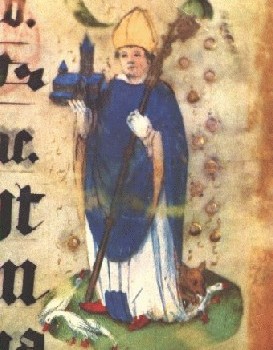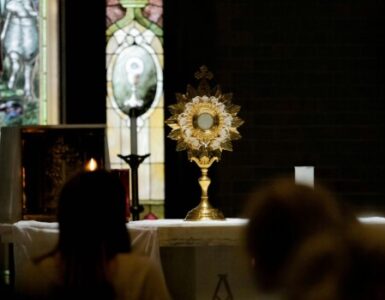Born in Friseland in the year 743, Ludger was part of a very noble family. At an early age Ludger went to stay in a monastery where he was taught by St. Gregory, a disciple of St. Boniface. Gregory’s piety made a great impression on the young Ludger and gave him the desire to follow in his footsteps. Because of Ludger’s progress in his spirituality and his studies, Gregory gave him the clerical tonsure.
Ludger then went to England where he continued his studies for the next four years under Alcuin, rector of a well-known and highly respected school at York. There Ludger applied himself to the study of Scriptures and the early Church Fathers. In 773, he returned home. Three years later St. Gregory died and his successor, Alberic, compelled Ludger to receive the holy order of priesthood. Ludger spent the next several years of his priesthood preaching and converting many pagans. He also founded many monasteries and built several churches.
When Saxons invaded the country Ludger was compelled to leave Friseland. He went to Rome and sought the advice of Pope Adrian. Discerning that God’s will was for him to retire, for the next three and a half years he did just that by going to Mount Cassino where he wore the habit and followed the rule of the Order, but did not make any religious vows. In 787, when Charlemagne conquered the Saxons and took back Friseland, Ludger returned and converted many Saxon pagans to the Catholic faith. Hildebald, archbishop of Cologne, ordained him bishop of Mimigard, a city that later became known as Munster, in the year 802.
Ludger was a Scripture scholar and read to his disciples every day from the Bible. He was very pious, always wearing a hair shirt concealed under his other clothing. He also fasted very often. He was generous to the poor, but held himself on a strict budget, never wasting his income and only allowing himself necessities. His principal care was to have a good and efficient clergy. To a great extent, he educated his students personally, and generally took some of them on his missionary tours. Since his sojourn at Monte Cassino, Ludger had entertained the idea of founding a Benedictine monastery. During the past years he had been looking for a suitable location and acquiring property. At length he decided upon Werden. It was only in 799 that building began in earnest, and in 804 that he consecrated the church.
On Passion Sunday, 809, Ludger heard Mass at Coesfeld (one of the churches he had had built), then went to Billerbeck, where at nine o’clock he again preached, and said his last Mass. That evening he expired peacefully and went to be with his Master.
Lessons
St. Ludger always put God above all else. When he was in prayer he refused to leave his meditation for anyone or anything. Once he was called to the court of the emperor, but told the chamberlain who came for him that he would have to wait until he finished his prayers. Several times the chamberlain returned for him but he was still at prayer. The courtiers considered this an act of contempt for his highness the emperor. Finally when Ludger appeared the emperor asked why he had taken so long to come. Ludger replied that while he held the emperor in the highest regard, God was in supreme authority and above even the emperor and thus was due the greater respect. He went on to say that while we are occupied with God, all else was to be erased from our minds and our total attention given to our Lord.
Prayer
Heavenly Father, may we learn from St. Ludger this great lesson of giving You our full attention while in prayer. Lord, forgive us for the times that we are easily distracted or so quickly leave you to answer a phone or talk to a friend. We thank you for your patience and mercy, dear Father, and pray that we are daily conformed to be more like your saints in heaven. In Christ’s name we pray. Amen.
Other Saints We Remember Today
Sts. Cletus and Marcellinus (304), Popes, MartyrsOur Lady of Good CounselSt. Alsa (Aldobrandesca) (1309), Widow
image: ER (Ed. Rahms?), Public domain, via Wikimedia Commons










